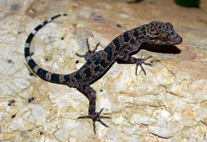Abstract
We describe two new species of the genus Cyrtodactylus on the basis of a new reptile collection from the limestone karst forest of Hoa Binh Province, northwestern Vietnam. Cyrtodactylus otai sp. nov. from Hang Kia—Pa Co Nature Reserve and Cyrtodactylus bobrovi sp. nov. from Ngoc Son—Ngo Luong Nature Reserve can be distinguished from each other and from their congeners by their genetic distinction and morphological differences in number of precloacal pores, femoral scales, ventral scales, lamellae, subcaudals and dorsal tubercle arrangement, as well as in size and color pattern. In phylogenetic analyses, both new species are nested in a clade containing taxa from northwestern and northcentral Vietnam and northern Laos, i.e., C. bichnganae and C. cf. martini from northwestern Vietnam, C. puhuensis from northcentral Vietnam, and C. spelaeus, C. vilaphongi, and C. wayakonei from northern Laos.

